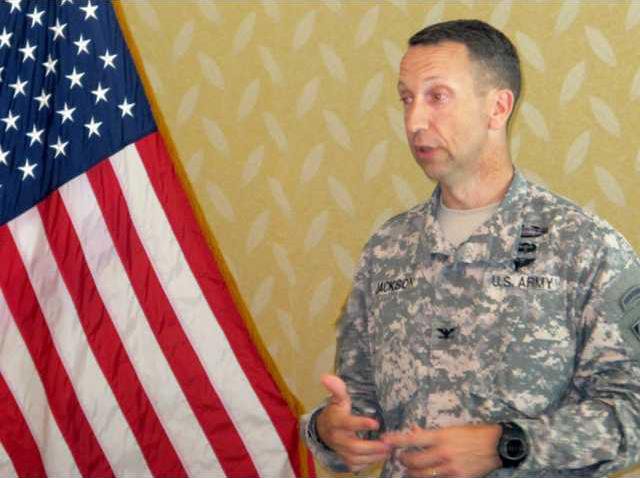The 3rd Infantry Division’s Chief of Staff-rear Col. Scott Jackson told Hinesville Rotary Club members Tuesday that the Marne Division’s 2nd Armor Brigade Combat Team is the last of the 12 brigade combat teams scheduled to be deactivated by 2017.
Jackson emphasized, however, that the timeline for the Spartan Brigade’s deactivation could be moved forward significantly if sequestration continues after Sept. 30. During the Rotary Club’s weekly business luncheon, he said he will take command of the Spartan Brigade on Friday, July 26 and lead it through its deactivation.
He explained that the current force reduction is the result of the Budget Control Act of 2011. To meet new budget requirements, he said the Army plans to reduce current active-duty soldiers from 570,000 to 490,000. That reduction includes the deactivation of the 12 BCTs, he said.
He re-emphasized that if sequestration continues, the Army, Army National Guard and Army Reserve might have to cut its overall numbers by another 100,000 soldiers.
Jackson, a graduate of the University of Notre Dame who started his career in 1990, said personnel reductions are not the only cost reductions affecting Fort Stewart and other installations.
“Just as we can’t bust the checkbook with personnel costs, we can’t build new buildings,” Jackson said. “We’ve wanted to build two new battalion areas, but it has not been funded for two years now.”
Despite budget cuts, he said the Army wants to ensure there will be no more “Task Force Smiths,” referring to the “speed bump” battalion sent to Korea on July 1, 1950 with a mission to delay the invading North Korean army.
The Army’s numbers drastically were reduced, along with funding for training and equipment, after World War II. He said Lt. Col. Charles B. Smith, commanding officer, 1st Battalion, 21st Regiment, 24th Infantry Division, was given orders to delay an overwhelming enemy force, which included armor, with poorly trained and ill-equipped soldiers. The unit’s position was overrun within hours July 5, 1950.
Jackson said the lessons learned soon were forgotten. When the Vietnam War ended in the mid-1970s, the Army’s budget once again drastically was cut and the force reduced.
He said this time, as the Army reduces its troop levels, it wants to be careful not to reduce its capability. He said the current policy is to retain the defense plan in a Pacific-theater posture and retain the current BCT mix. The BCT mix includes heavy- or armor-brigade combat teams, light infantry brigade combat teams and Stryker brigade combat teams.
“Every single installation that is not in the Pacific (theater) lost a brigade,” Jackson said, noting that Fort Hood, Texas, is losing two of its five BCTs, and Fort Knox, Ky., is losing its one BCT. “Everybody paid the bill. But, as I tell my battalion commanders, they’re not getting fired. They’re just going to work for someone else. Many of their soldiers will not leave Fort Stewart. Their families will not leave Fort Stewart. And their equipment will not leave Fort Stewart.”
He said the 2nd ABCT currently consists of about 3,200 soldiers. About 800 soldiers with the 1st Battalion, 30th Infantry Regiment will transition to the 1st ABCT. An equal number of soldiers with the 1st Battalion, 64th Armor Regiment will transition to Fort Benning and the 3rd ABCT, he said. The Spartan Brigade’s 1st Battalion, 9th Field Artillery Regiment will be divided in two, with half going to the 1st ABCT and half to the 3rd ABCT.
Jackson said Fort Stewart will keep about 1,400 soldiers from the Spartan Brigade. And though the installation will lose up to 1,800 soldiers to Fort Benning or through attrition, Stewart will continue to receive additional soldiers from smaller units, such as the Gray Eagle Unmanned Aerial Vehicle, civil affairs, fire brigades and heavy-equipment transport.
He said that in 2001 there were a little more than 15,000 soldiers at Fort Stewart. By 2012, the number of soldiers had swollen to more than 21,000. He said by 2019 the total number of soldiers would be fewer than 20,000.
“The bottom line is that Fort Stewart is safe,” Jackson said, explaining that except for a possible extension of sequestration, he does not see the installation suffering greater personnel cuts. “The Army recognizes the importance of Fort Stewart.”
Prior to allowing Mayor Jim Thomas to introduce Jackson as guest speaker, Rotary Club President Marcus Sack said the club had agreed to send a check for $500 to the Ronald McDonald House in memory of club member Gary Dodd, who recently passed away after a long battle with cancer.
Marne BCT last to be deactiviated
Stewart keeps 1,400 Spartan soldiers, lose up to 1,800


Sign up for our E-Newsletters

